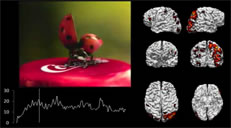Emmy Awards Match Neuromarketing Study
 The recent Creative Arts Emmy Award result had an interesting neuromarketing tie-in: Super Bowl commercials found to be emotionally engaging using EEG and biometric measures fared unusually well in the Emmy award competition:
The recent Creative Arts Emmy Award result had an interesting neuromarketing tie-in: Super Bowl commercials found to be emotionally engaging using EEG and biometric measures fared unusually well in the Emmy award competition:
Earlier this year, Sands Research Inc., a leading provider of neuromarketing research studies, completed an extensive study into all 72 television commercials aired during NBC`s 2009 Super Bowl XLIII broadcast. Each of the TV spots were ranked by the Company`s Neuro-Engagement Factor (NEF) scoring system which is based upon measuring EEG (brain wave) activity from viewers and Sands Research`s proprietary software and algorithms that measures the viewer`s attention levels.
Three out of the top five commercials identified from that Super Bowl study were nominated for the coveted Academy of Television Arts and Sciences` Creative Arts Emmy Award. This past weekend, top ranked Coca-Cola`s “Heist” from Wieden + Kennedy, won the 2009 Emmy Award for outstanding commercial at the Creative Arts Emmy Awards. [From Reuters Press Release – Sands Research 2009 Super Bowl Neuromarketing Study Matches Creative Arts Emmy Awards.]
Is this coincidence? Perhaps not… According to Sands, “a good ad will always have a large spike in brain activity within the first 800 milliseconds of the ad and sustain a high plateau across the length of the commercial.” It seems likely that many ads found to be engaging this way would also capture the attention of judges.
Of course, that doesn’t mean the ad will actually sell product. An ad can entertain effectively while not leading to sales or even improving brand recall. Nevertheless, such studies should be able to weed out the duds – ads that are supposed to be entertaining and engaging but miss that mark.
Sands Research rankings of all 2009 Super Bowl ads can be found here.
